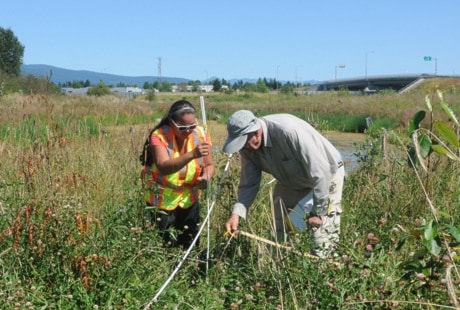Before the excavators and dumptrucks came, before the townhomes and concrete and asphalt, there was water, and there was life.
“Before all this,” says Ashley Adams, a member of the Katzie First Nation, sweeping her arm in the direction of the subdivisions on Airport Way in Pitt Meadows and the grey approaches to the Golden Ears Bridge, “You could paddle from the Fraser River to Pitt Lake on the Katzie Slough.”
With the construction of the bridge and suburban sprawl encroaching from all sides, a small algae-covered manmade pond named Blind Channel is all that remains.
“This used to be swamp, and this was where we used to hunt,” says Adams.
“It used to be full of ducks and coyotes and salmon.”
If everything goes according to plan, it will be once again.
Blind Channel was completed last November by the Ministry of Transportation and Infrastructure to compensate for fish habitat destroyed elsewhere by the construction of the Golden Ears Bridge.
Adams, 22, is one of the Katzie youth taking part in a program to learn how to manage the pond, and to ensure that wildlife returns.
The program is operated by the Alouette River Management Society, and funded through the Pacific Salmon Foundation.
“The idea is to get the community involved,” says Greta Borick-Cunningham, the acting executive director with ARMS.
“This is traditional Katzie area, and they have the local knowledge.”
The Katzie volunteers will serve as the eyes and ears of the community, to ensure Blind Channel rebounds, and that nature returns to the site.
Paul James, of the Katzie Development Corporation, says the partnership allows the Katzie First Nation to take control over the future of at least one small part of their traditional territory. Just as important, he is hoping for job opportunities for some of young people taking part in the program.
“We’re hoping the training opens up new doors for them,” says James.
“They’re developing skills, and that builds confidence, and gives them opportunities.”
Thanks to the experience she has gained through the partnership, Adams says she hopes to pursue a career in environmental sciences.
“The training is pretty awesome,” says Adams. “It sure beats being stuck in an office all day.”
On this summer’s day, Adams is joined by Borick-Cunningham and trainer ZoAnn Morten, and other volunteers, as they catalogue, sample, and map the pond’s flora under the sweltering sun. Using a digital camera, they hope to document the growth of the many plant species planted around the pond.
Adams has no trouble working the digital camera, and like many young people, she is comfortable with most things high-tech.
“All the kids are very confident with the technology,” says Morten. “They just need to learn how to apply it.”
Adams takes a photo of a small shrub for their records. Like many of the trees planted around the pond, it is slowly being strangled by wild grasses and clover.
“There’s a great variety here, but some [species] are doing better than others,” says Morten.
Less than a year into the five-year project to bring life back to this small section of the Katzie Slough, and Blind Channel is in rough shape.
Problem is, the pond is being choked.
Algae has covered most of the surface of the pond and clogged the shallower portions, trapping water in the pond.
A cycling path built to skirt around the pond is a popular route for joggers and cyclists, but its construction has resulted in the compression of the soil underneath, reducing the amount of groundwater flowing into the pond, Morten believes.
The cedars and pines are already dying, just 10 months after they were planted. The clay-rich soil dredged from the bottom of the pond in which they were planted isn’t helping matters, either.
“The ground is so dry, it’s not holding any water,” says Morten.
“But at the beginning you don’t expect much.”
It’s a manmade ecosystem, she points out, and playing with Mother Nature can yield mixed results, especially with something so complex.
“We want it to be back to normal just like that,” Morten says. “But it doesn’t work like that. It takes time.”
However, the cottonwoods are thriving. Soon they will provide shade for the pond, and with shade comes cooler water temperatures, improving the fish habitat.
“So far we’ve found pumpkinseed [sunfish], sticklebacks, salamanders, and frogs,” said Morten. The coho that used to spawn in Katzie Slough, are noticeably absent, however.
A lone heron is perched upon one of the many cedar stumps placed around the pond, attracted by the pond’s frogs.
The large wading bird is harbinger of life returning to the pond, Morten hopes.
“It’s a good sign,” she says. And with that, the heron flies silently away, off to better hunting grounds.
The area will rebound, albeit slowly, says Morten. Mother Nature works on her own schedule.
In the meantime, she has help from the likes of Adams and her peers.
“You can’t stop development, but you can preserve what’s left and make sure development is responsible,” says Adams.
